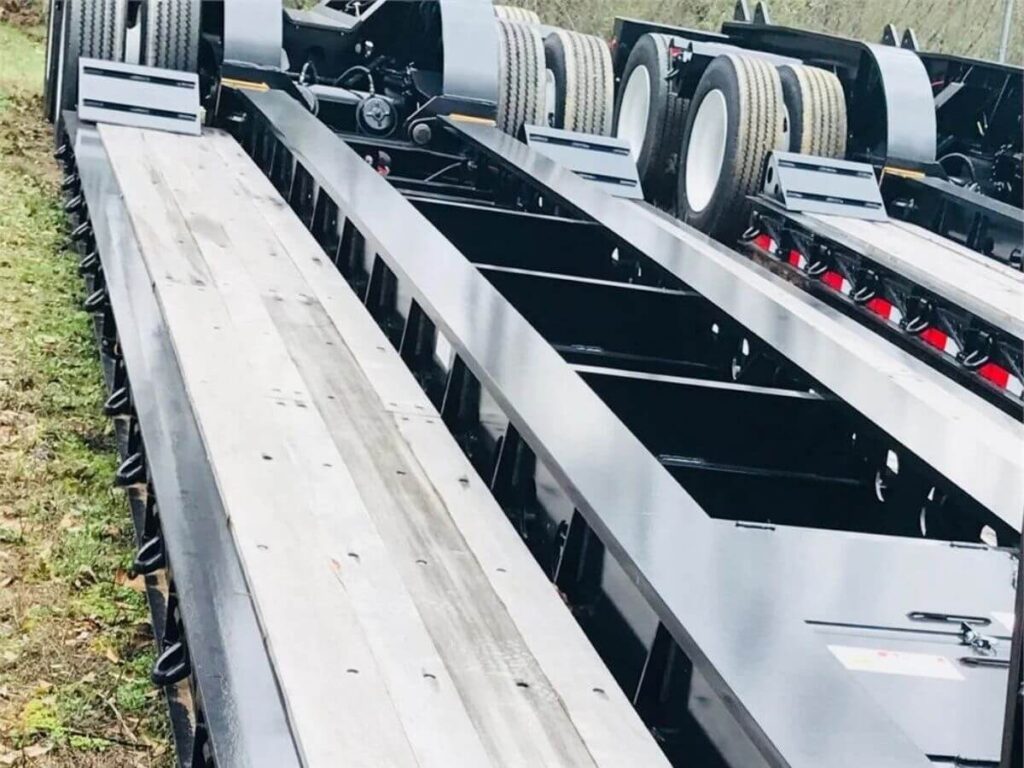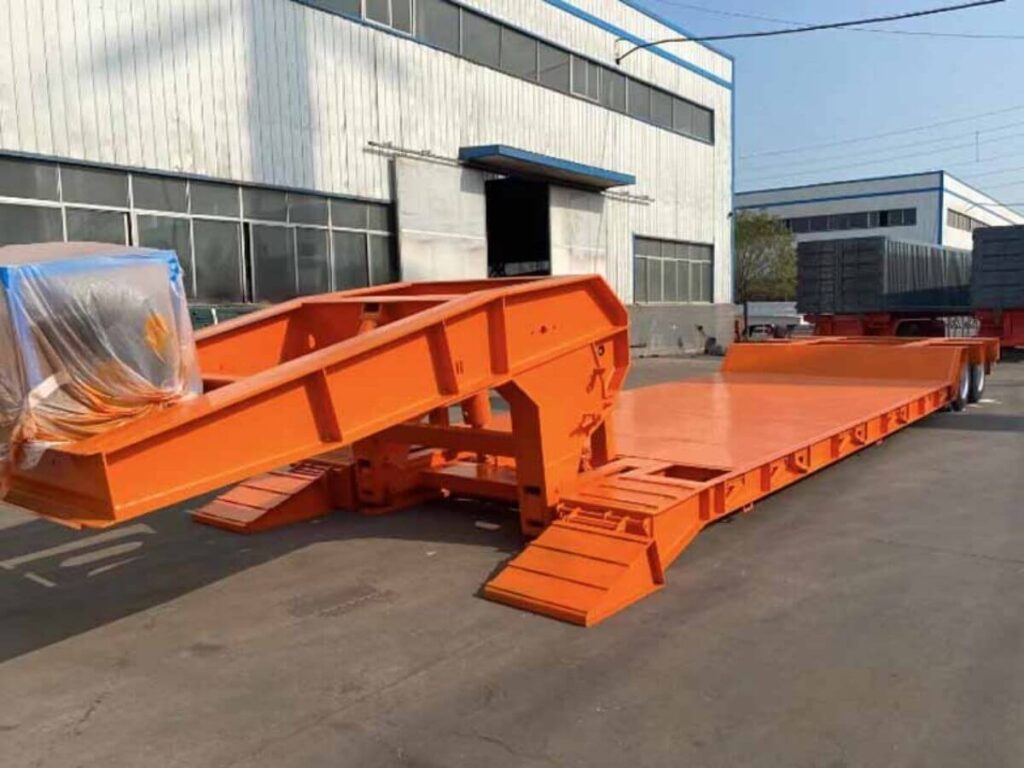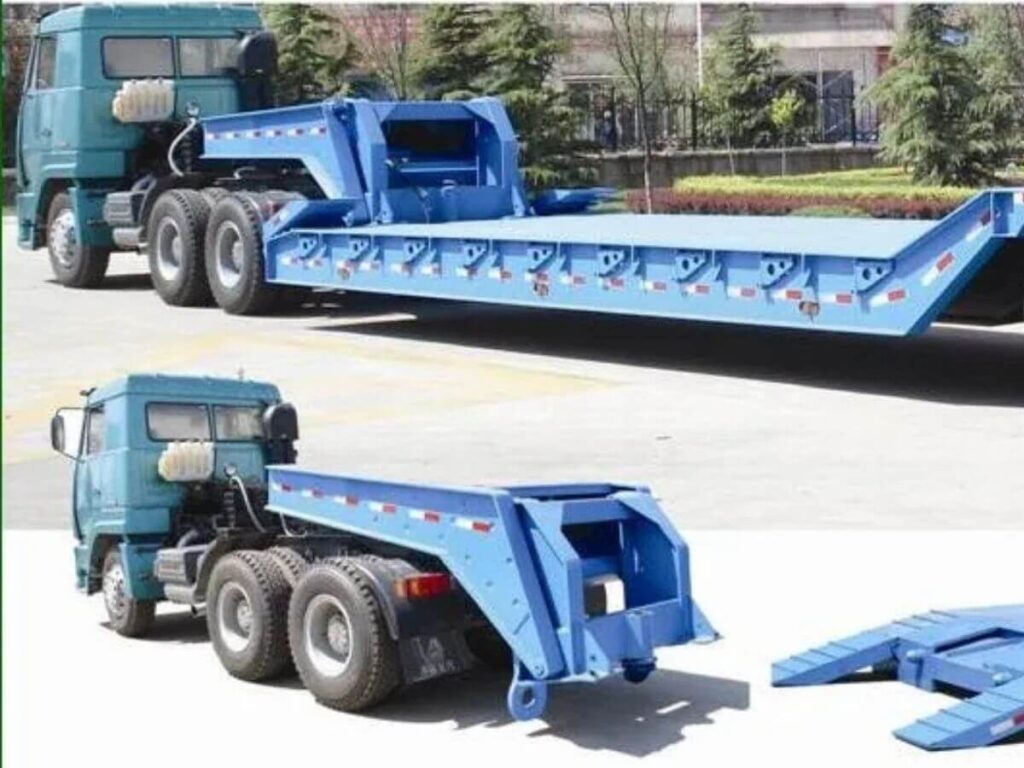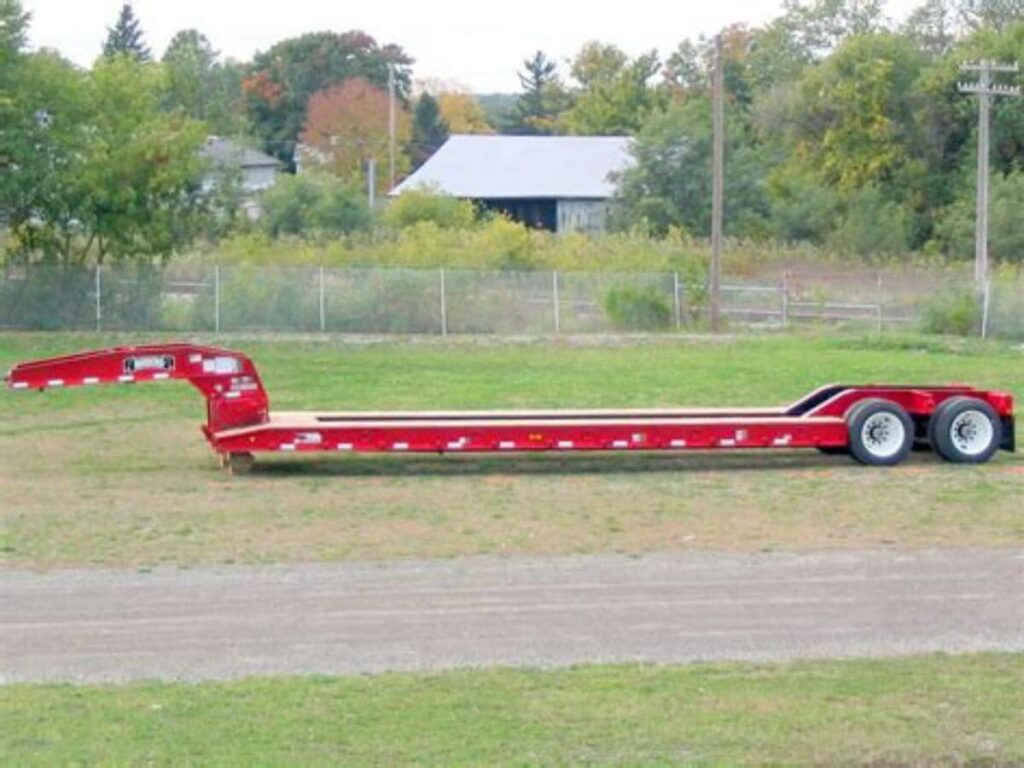Have you ever looked at a trailer and thought, “How am I supposed to load that?”
That’s how a customer felt when trying to move his crawler tractor. Standard ramps wouldn’t cut it. Too steep. Too risky.
That’s when I showed him a removable gooseneck trailer.
I’ve been around trailers for years—advising buyers, talking with mechanics, and seeing what works in the real world. I’m not here to sell you anything. I’m here to help you figure out what fits your haul.
In this article, I’ll break down everything you need to know about removable gooseneck trailers. I’ll explain how they work, why some people swear by them, and what to watch out for.
By the time you finish reading, you’ll know if this trailer fits your needs—or if another option makes more sense.
So let’s begin!
1. What Is a Removable Gooseneck Trailer?
If you’ve ever tried loading a heavy machine onto a trailer with steep ramps, you know how risky that can get. I once helped a client whose excavator got stuck halfway up the ramp. They were lucky it didn’t tip.
That’s when they switched to a removable gooseneck trailer, also called an RGN.
An RGN is a type of low-bed trailer with a detachable front section, known as the gooseneck. Once it’s removed, the trailer’s deck drops to ground level, making it easy to drive equipment on and off from the front—no ramps, no lifting.
This design works especially well for bulky, heavy, or tall machinery. That’s why it’s common in industries like construction, mining, and energy.
At Rhinotrail, we build removable gooseneck trailers for all kinds of jobs—from hauling standard excavators to transporting oversized turbines. Over the years, I’ve seen how the right RGN can make a job faster, safer, and more efficient.
If you’re wondering whether this type of trailer fits your work, the next sections will help you figure that out.
Types of Removable Gooseneck Trailers
- Standard RGN: Good for general hauling like excavators, bulldozers, or pavers. Simple, strong, and reliable.
- Stretch RGN: Ideal for long items like wind blades, steel beams, or piping. The trailer extends to give you extra length when needed.
- Mechanical Detachable RGN: Lower cost option. The gooseneck disconnects manually. It takes a bit more labor but gets the job done.
- Hydraulic Detachable RGN: Uses hydraulic power to raise and lower the neck. Easier to operate. Saves time on loading.
- Drop Side RGN: The center deck is lowered between side rails. Perfect when your load is tall and you want to stay under height limits.
- Multi-Axle RGN: Designed for extremely heavy loads. Extra axles spread out the weight. Used in mining, oilfields, and energy transport.
Each one has its own use. It really depends on what you’re hauling and how often you’re doing it.

2. How Does a Removable Gooseneck Trailer Work?
The first time I saw a removable gooseneck trailer in action, I was honestly surprised at how smooth the process was. No ramps. No awkward angles. Just a clean, fast load from the ground.
Here’s how it works.
Detachment Mechanism
The gooseneck is the front part of the trailer that connects to the truck. On an RGN, this section detaches, allowing the front of the trailer to lower to the ground. That’s what makes front loading possible.
There are 2 main types of detachment systems:
- Hydraulic Detachable Gooseneck: Uses hydraulic power to raise and lower the neck. This system is faster and easier to operate. It’s a good fit if you load and unload often or want to cut down on manual work.
- Mechanical Detachable Gooseneck: Uses manual pins and tools to disconnect the neck. It takes more time and physical effort, but it’s more affordable and has fewer moving parts.
Both systems allow you to load from the ground. The main difference is how much labor and time you’re willing to trade for cost.
Loading and Unloading Process
Once the gooseneck is removed and the deck is lowered, loading becomes straightforward:
- Drive the equipment directly onto the deck from the front.
- Secure the load using chains or straps.
- Reconnect the gooseneck to the trailer.
- You’re ready to haul.
Many operators find this process faster and more stable than using ramps, especially on uneven surfaces or when working with large machines.
Front-Loading Advantage
Loading from the front offers a few key benefits:
- You don’t need ramps, cranes, or extra equipment.
- It’s easier on low-clearance machines.
- There’s less risk of tipping or damage during loading.
- The process is faster and safer for most crews.
If you move oversized or heavy cargo, front loading can make your day easier—and your worksite safer.
3. Key Features of an RGN Trailer
When you’re hauling heavy or oversized equipment, the trailer you choose matters. I’ve seen people struggle with the wrong setup—damaged cargo, delays, or fines they didn’t see coming. That’s why it helps to understand what an RGN trailer offers. These features can make your job easier, safer, and more efficient.
Low Deck Height
Most RGN trailers sit between 18 to 24 inches off the ground. That gives you more room to haul tall equipment without going over height limits. You might avoid special permits, and your load will ride lower and more stable on the road.
High Weight Capacity
Depending on your trailer’s setup, you can haul between 40,000 and 150,000 pounds—or even more. This makes it a solid choice if you’re moving dozers, cranes, or large generators. RGN trailers are designed to follow DOT axle spacing and load rules, so you can stay legal as long as you load it right.
Axle Configurations
You can match the number of axles to your load. Lighter cargo might only need two axles. For heavier loads, you might go with three, four, or more. You can also add boosters or jeeps to handle extreme weight. The right axle setup helps you spread out the load and protect both your trailer and the road.
Detachable Gooseneck
This feature lets you lower the front of the trailer to the ground, so you can drive equipment on without ramps. You’ve got two choices here. Hydraulic goosenecks: faster and easier to use. Mechanical goosenecks: more hands-on, but easier on your budget.

4. Typical Uses for RGN Trailers
If you’re wondering whether a removable gooseneck trailer fits your kind of work, the answer depends on what you haul. Over the years, I’ve worked with people in construction, mining, farming—you name it. And I’ve seen how an RGN can make tough jobs easier. Here’s how you might use one in your line of work:
- Construction: If you move machines like excavators, bulldozers, pavers, or cranes, an RGN trailer is made for that. You can load right from the ground and head to the next site without delays. That front-loading design helps when space is tight or the ground is uneven.
- Mining: Hauling equipment in mining isn’t easy. The machines are big, heavy, and often in remote areas. RGN trailers handle this kind of work well. You can load dump trucks, drills, crushers, and other large gear without needing extra tools. Plus, the axle setups help carry extreme weight safely.
- Logistics and Transport: If you’re in long-distance hauling, especially with oversized machinery, RGN trailers are a strong option. Many heavy-haul contracts require them. Their low deck height and front-loading ability make them ideal for crossing state lines with fewer restrictions.
- Manufacturing and Industrial: Big equipment like CNC machines, generators, or large fabrication tools can be hard to move. With an RGN, you can load directly from the shop floor and move them to new locations without the need for cranes or ramps.
- Agriculture: Farm gear keeps getting bigger—combines, sprayers, and harvesters aren’t easy to move. If you haul between farms or bring in equipment for service, an RGN trailer gives you the space and strength you need.
- Oil, Gas, and Energy: From rig skids to wind turbine parts, energy equipment is often oversized and awkward. RGN trailers are commonly used in these industries because they can handle both the weight and the shape of these loads.
- Independent Buyers: If you’re a contractor or owner-operator, you probably need to haul a mix of equipment. An RGN gives you flexibility. Whether you’re moving your own gear or offering hauling services, it covers a lot of ground.
If your work involves big equipment, odd shapes, or serious weight, there’s a good chance an RGN trailer can help you get the job done right.

5. RGN vs. Other Trailer Types
If you’ve ever struggled with loading, permits, or weight issues, you’re not alone. I’ve seen companies try to cut corners with the wrong trailer—only to pay for it later. This table helps you compare RGN trailers to other common options so you can make the right call from the start.
| Trailer Type | Deck Height | Load Style | Weight Capacity | Best For | Limitations | Example Use |
| Removable Gooseneck (RGN) | 18–24 in | Front load (ground-level) | 40,000–150,000+ lbs | Tall, heavy, or self-propelled equipment | Heavier build; more expensive | Hauling excavators, cranes, or large tanks |
| Lowboy (Fixed Gooseneck) | 24–30 in | Rear load (with ramps) | 35,000–80,000 lbs | Medium-sized machines | No front loading; limited height room | Moving backhoes, pavers, or rollers |
| Flatbed Trailer | 48–60 in | Rear/side load (with forklift/crane) | 40,000–50,000 lbs | Palletized or packaged goods | Too high for large machines; no ground-level access | Shipping crates, lumber, or containers |
| Step Deck (Drop Deck) | 36–48 in | Rear load | 40,000–60,000 lbs | Tall cargo under 10 ft. | Not for heavy/tall equipment | Moving tractors, pipe bundles, or tanks |
| Beam Trailer | Open-frame (variable) | Rear load (with ramps) | 50,000–120,000+ lbs | Tracked machines with high ground clearance | No full deck; limited use | Hauling large drills or mining dozers |
| Extendable Flatbed | 36–60 in | Rear/side load | 30,000–60,000 lbs | Long, light cargo (pipes, beams) | Not for heavy/tall equipment | Hauling wind blades or steel lengths |
| Extendable Step Deck | 36–48 in | Rear load | 30,000–60,000 lbs | Long cargo that’s a bit taller | Limited weight; still not for large machines | Transporting tanks or long industrial parts |
6. Common Mistakes When Using RGN Trailers
One driver called me, sounding frustrated. “The load shifted on the road. The straps aren’t holding,” he said. We’d gone over tie-down techniques earlier, but he’d skipped a step. One small mistake—missing a safety check—ended up costing him time and money. That moment stuck with me. Even experienced operators make these easy-to-avoid mistakes. So, what can you do to avoid them?
Overlooking Weight Distribution
Many people assume their load is balanced, but if the weight isn’t distributed correctly across the axles, you’re asking for trouble. This can lead to fines, mechanical breakdowns, or issues with handling while driving. Always check the axle weight before hitting the road to keep things safe and compliant.
Wrong Trailer Type for the Load
One mistake I’ve seen too often is choosing the wrong trailer for the load. For example, using a standard RGN when you need an extendable, or not having enough axles to handle the weight, can lead to delays and damage. Always match the trailer’s size and axle configuration to the load’s requirements.
Improper Loading Technique
Skipping important steps during loading can lead to accidents. Not securing equipment properly, forgetting wheel chocks, or uneven loading can all create major risks on the road. Take the time to properly load and secure your equipment, even if you’re in a rush. It’ll save you time and hassle later.
Neglecting Maintenance
Hydraulic systems and other trailer components need regular attention. A small leak or worn-out part can quickly turn into a breakdown. Don’t skip maintenance—inspect your trailer before and after each haul to avoid unexpected issues.

7. What to Look for When Choosing an RGN Trailer
Choosing the right removable gooseneck (RGN) trailer is important for your hauling needs. Whether you’re transporting heavy machinery or long equipment, you need a trailer that fits your job. Here’s what you should look for when selecting an RGN.
#1 Type of Cargo
Think about what you haul most often. Are you transporting large, self-propelled equipment like bulldozers and cranes, or long loads like pipes and beams? If you’re moving tall or heavy equipment, an RGN trailer is perfect because it allows for front-loading. For long equipment, an extendable RGN is a better choice, while a standard RGN is great for general equipment.
#2 Hydraulic or Mechanical
The gooseneck on an RGN is what sets it apart from other trailers, allowing for ground-level loading. You’ll find two types: hydraulic and mechanical. Hydraulic systems are easier and faster, especially if you load and unload frequently. Mechanical systems are more affordable but require manual effort to detach and reconnect. Consider how often you’ll be using the trailer and how much convenience matters to you.
#3 Load Capacity and Deck Specifications
At Rhinotrail, we offer trailers with a wide range of load capacities to meet different needs. Whether you need a trailer that carries 40,000 lbs or one that can handle over 150,000 lbs, we have options for you. The deck length and extension capability are just as important—make sure the trailer’s deck is long enough for your equipment.
#4 Legal Compliance and Permits
When hauling oversized loads, compliance with state and national regulations is crucial. At Rhinotrail, we understand the importance of legal compliance and offer trailers built to meet these requirements. Depending on your cargo size and weight, we can customize trailers to match the necessary rules for height, width, and axle spacing—helping you stay compliant and avoid fines.

Conclusion
Now that you know what to look for when choosing an RGN trailer, it’s time to take action. Consider your specific hauling needs, your legal requirements, and your budget.
Whether you’re transporting self-propelled equipment or oversized loads, the right trailer will make all the difference.
Think about how much time and money you could save with the right setup.
Ready to move forward?
Contact us today, and let’s get your hauling business on track.


